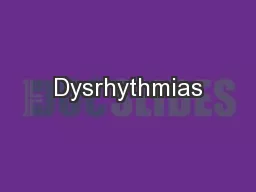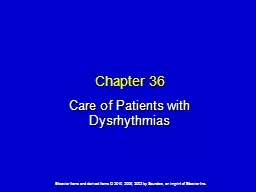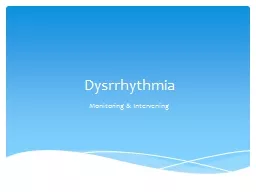PPT-Dysrhythmias
Author : ellena-manuel | Published Date : 2017-12-18
Dr Jehad Rababah Cardiac Conduction System Automaticity Excitability Conductivity Contractility Properties of Cardiac Cells 3 ECG Strip Reflects the electrical
Presentation Embed Code
Download Presentation
Download Presentation The PPT/PDF document "Dysrhythmias" is the property of its rightful owner. Permission is granted to download and print the materials on this website for personal, non-commercial use only, and to display it on your personal computer provided you do not modify the materials and that you retain all copyright notices contained in the materials. By downloading content from our website, you accept the terms of this agreement.
Dysrhythmias: Transcript
Dr Jehad Rababah Cardiac Conduction System Automaticity Excitability Conductivity Contractility Properties of Cardiac Cells 3 ECG Strip Reflects the electrical activity in the heart Small 005sec amp large 02sec boxes . Care of Patients with Dysrhythmias. Review of Cardiac Electrophysiology. . Automaticity. Excitability. Conductivity. Contractility. Cardiac Conduction System. Cardiac Conduction System. . (Cont’d). Emergencies. 0800-0915. A-Z’s of . Perianesthesia. Emergencies. . What to do first when it All goes Wrong?. Objectives. Identify causes of complications in the . perianesthesia. /perioperative arena.. Review of Cardiac Electrophysiology. . Automaticity. Excitability. Conductivity. Contractility. Cardiac Conduction System. Cardiac Conduction System. . (Cont’d). . Sinoatrial node:. . Electrical impulses at 60 to 100 beats/min. Cardiac . electrical activity can be monitored by using . ECG; . a . resting, ambulatory (. Holter. . monitoring), continuous cardiac monitoring, or . by telemetry. Cardiac dysrhythmias are heartbeat disturbances (beat formation, .
Download Document
Here is the link to download the presentation.
"Dysrhythmias"The content belongs to its owner. You may download and print it for personal use, without modification, and keep all copyright notices. By downloading, you agree to these terms.
Related Documents




